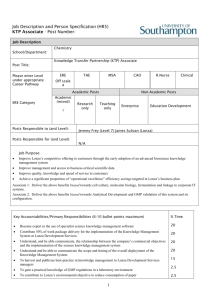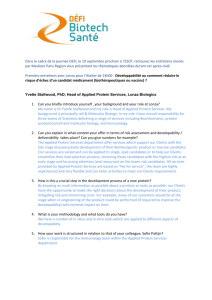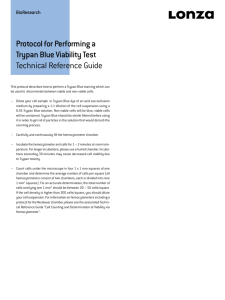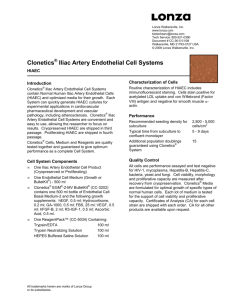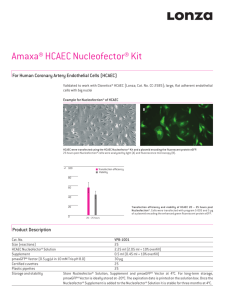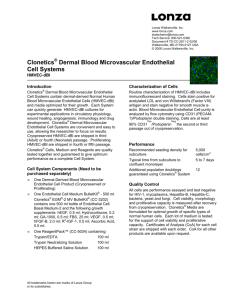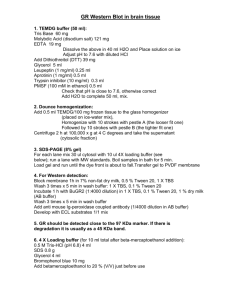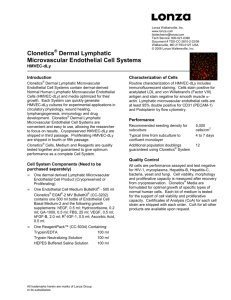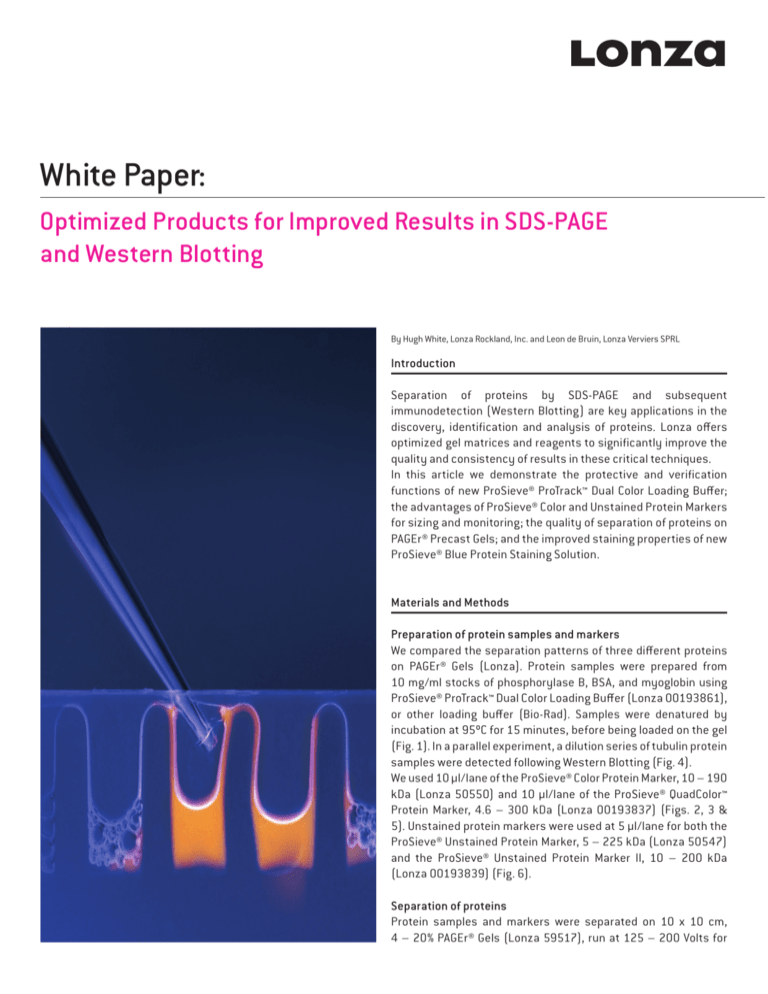
White Paper:
Optimized Products for Improved Results in SDS-PAGE
and Western Blotting
By Hugh White, Lonza Rockland, Inc. and Leon de Bruin, Lonza Verviers SPRL
Introduction
Separation of proteins by SDS-PAGE and subsequent
immunodetection (Western Blotting) are key applications in the
discovery, identification and analysis of proteins. Lonza offers
optimized gel matrices and reagents to significantly improve the
quality and consistency of results in these critical techniques.
In this article we demonstrate the protective and verification
functions of new ProSieve® ProTrack™ Dual Color Loading Buffer;
the advantages of ProSieve® Color and Unstained Protein Markers
for sizing and monitoring; the quality of separation of proteins on
PAGEr® Precast Gels; and the improved staining properties of new
ProSieve® Blue Protein Staining Solution.
Materials and Methods
Preparation of protein samples and markers
We compared the separation patterns of three different proteins
on PAGEr® Gels (Lonza). Protein samples were prepared from
10 mg/ml stocks of phosphorylase B, BSA, and myoglobin using
ProSieve® ProTrack™ Dual Color Loading Buffer (Lonza 00193861),
or other loading buffer (Bio-Rad). Samples were denatured by
incubation at 95ºC for 15 minutes, before being loaded on the gel
(Fig. 1). In a parallel experiment, a dilution series of tubulin protein
samples were detected following Western Blotting (Fig. 4).
We used 10 µl/lane of the ProSieve® Color Protein Marker, 10 – 190
kDa (Lonza 50550) and 10 µl/lane of the ProSieve® QuadColor™
Protein Marker, 4.6 – 300 kDa (Lonza 00193837) (Figs. 2, 3 &
5). Unstained protein markers were used at 5 µl/lane for both the
ProSieve® Unstained Protein Marker, 5 – 225 kDa (Lonza 50547)
and the ProSieve® Unstained Protein Marker II, 10 – 200 kDa
(Lonza 00193839) (Fig. 6).
Separation of proteins
Protein samples and markers were separated on 10 x 10 cm,
4 – 20% PAGEr® Gels (Lonza 59517), run at 125 – 200 Volts for
60 – 90 minutes, in a Lonza PAGEr® Minigel Chamber
(Lonza 59905), using a 1X AccuGENE® Tris-Glycine SDS buffer
(Lonza 50880).
Detection of proteins on a gel
Unstained protein markers and protein samples were stained
using ProSieve® Blue Protein Staining Solution (Lonza 00193862),
and compared with standard Coomassie Brilliant Blue staining
(Fig. 7).
Transfer of proteins to a blot
Gels were blotted on a membrane (Protran BA85-SD nitrocellulose)
by semi-dry transfer (25 V at 400 mA for 60 min) using standard
Towbin transfer buffer (1X Tris Glycine with 20% methanol added).
To verify the complete transfer of the proteins on to the blot, we
used both the pink dye component of the ProSieve® ProTrack™
Dual Color Loading Buffer (Lonza 00193861), and the ProSieve®
Color Protein Markers. (Fig. 3).
The α-tubulin samples were detected using α-tubulin specific
monoclonal antibody (Accurate Scientific) and a traditional
HRP tagged secondary antibody, or using the One-Step Western
Advanced Kit, Mouse (GenScript L00242). SuperSignal West Pico
reagents were used for the ECL detection. Bands were excited
using a Dark Reader® transilluminator and imaged (Fig. 4)
Fig. 2. Monitoring separation with ProSieve® Color Protein Marker and ProSieve®
ProTrack™ Dual Color Loading Dye. Dilution series of tubulin run on a 4 – 20% PAGEr®
Gold gel. The ProSieve® QuadColor™ Protein Marker in the second lane provided visual
identification of run distance on the gel. ProSieve® ProTrack™ Dual Color Loading
Buffer in the other lanes indicated the running front of the proteins (blue dye), and
verification of the subsequent transfer efficiency of the proteins to the blot (pink
dye).
Results
0.5 µg
1
1.0 µg
2
3
2.0 µg
4
5
6
-
Fig. 1. Protection of protein samples using ProSieve® ProTrack Dual Color Loading
Buffer. Dilutions of Phosphorylase B, BSA, and myoglobin proteins, separated on a
4 – 20% PAGEr® Gold Gel. Lanes 1, 3 and 5 are protected by ProSieve® ProTrack™ Dual
Color Loading Buffer, Lanes 2, 4 and 6 are proteins prepared and run in a standard
loading buffer. Notice the amount of degraded proteins in the non-protected lanes.
Fig. 3. Confirmation of protein transfer with ProSieve® QuadColor™ Protein Marker
and ProSieve® ProTrack Dual Color Loading Buffer. Dilution series of tubulin separated
on a 4 – 20% PAGEr® Gold gel, and then blotted onto a membrane. Bands from the
ProSieve® QuadColor Protein Marker and the pink dye from the ProSieve® ProTrack™
Dual Color Loading Buffer transferred to the membrane, providing clear indication of
protein transfer efficiency prior to membrane staining.
5 – 225 kDa 10 – 200 kDa
A)ProSieve® ProTrack™ Dual Color Loading Buffer
225 –
– 200
– 150
– 120
–100
150 –
100 –
75 –
– 70
50 –
– 50
– 40
35 –
B)Standard Loading Buffer
– 30
25 –
– 20
– 15
15 –
– 10
10 –
Fig. 4. Western detection of protein samples prepared with ProSieve® ProTrack™
Dual Color Loading Buffer. Detection of tubulin dilution series following blotting; Gel A
used samples prepared with ProSieve® ProTrack™ Dual Color Loading Buffer, while Gel
B used samples prepared with standard loading buffer. Note the higher sensitivity
of transfer and no evidence of degradation (lower MW bands) with the samples
prepared in ProSieve® ProTrack™ Dual Color Loading Buffer.
kDa
184 –
121 –
85 –
52 –
41 –
27 –
21 –
14 –
11 –
1
2
3
4
5
6
7
8
9
10
11 12
5–
Fig. 6. ProSieve® Unstained Protein Markers. Unstained markers run on a 10 x 10 cm,
4 – 20% PAGEr® Gel, and stained with ProSieve® Blue Protein Staining Solution. Lane
1 ProSieve® Unstained Protein Marker, 5 – 225 kDa; Lane 2 ProSieve® Unstained
Protein Marker II, 10 – 200 kDa.
A) ProSieve® Blue Protein Staining Solution
kDa
– 300
– 250
– 170
– 140
– 100
– 70
– 55
– 40
– 25
– 15
– 10
– 4.6
Fig. 5. Comparison ProSieve® Color Protein Markers with other popular color
markers. Protein color markers from various suppliers run on a 10 x 10 cm 4 – 20%
PAGEr® Gel. Lanes 3, 4, 9 and 10 contain Lonza markers. Lane 1 Bio-Rad® Precision
Plus Dual Color Standard; Lane 2 Sigma ColorBurst™ Electrophoresis Marker; Lane 3:
Lonza ProSieve® Color Protein Marker; Lane 4 Lonza ProSieve® QuadColor™ Protein
Marker; Lane 5 Invitrogen BenchMark™ Pre-Stained Ladder; Lane 6 Invitrogen Novex®
Sharp Pre-Stained Standard; Lane 7 GE Full Range Rainbow™ Marker; Lane 8 Pierce
3-Color Pre-Stained Marker; Lane 9 Lonza ProSieve® Color Protein Marker; Lane 10
Lonza ProSieve® QuadColor Protein Marker; Lane 11 Invitrogen SeeBlue® Plus 2 PreStained Standard; Lane 12 Bio-Rad® Precision Plus Kaleidoscope™ Standard. Note
the sharpness of the bands and low background with the Lonza markers vs. some
other color markers.
500
250
125
62.5
31.25
15.6
7.8
3.9
1.95
B) Coomassie Blue
500
250
125
62.5
31.25
15.6
7.8
3.9
1.95
Fig. 7. Gel staining using ProSieve® Blue Gel Stain. Dilution series of a 15 kDa band
separated on a 4 – 20% PAGEr® Gel and then stained with ProSieve® Blue Protein
Staining Solution (Lonza, Gel A) or Coomassie Blue (Gel B).
Conclusion
Lonza offers an optimized set of products for protein separation
and Western Blotting that, when used together, significantly
improve protein integrity, resolution quality and Western transfer
efficiency.
New ProSieve® ProTrack™ Dual Color Loading Buffer protects
proteins during the sample preparation phase, and during SDSPAGE, by stabilizing pH fluctuations caused by temperature
differences, that can lead to degradation of proteins (Fig. 1). Use
of ProTrack™ not only protects protein integrity in SDS-PAGE, but
also improves the level of transfer in Western Blotting (Fig. 4).
The two dyes incorporated in this buffer function as run front
indicator (Fig. 2), and as verification of transfer efficiency (Fig.
3).
ProSieve® Unstained Protein Markers exhibit sharp bands for
accurate sizing of unknown protein bands over a broad size range.
ProSieve® Color Protein markers provide sharp, colorful visual
positioning of proteins during and after SDS-PAGE (Fig. 2) and
provide accurate confirmation of Western transfer (Fig. 3).
New ProSieve® Blue Protein Staining Solution is approximately
10-times more sensitive than a standard Coomassie stain
(detecting down to 2 – 4 ng of protein). Quantitative image analysis
shows a linearity of staining with ProSieve® Blue Protein Staining
Solution in the range shown (1 – 500 ng). Further, ProSieve® Blue
Stain is fast and simple to use, does not require any destaining,
and overstaining is not possible.
Finally, PAGEr® Gels provide the ideal matrix for protein separation,
yielding consistently sharp bands, fine resolution, and efficient
transfer of proteins up to 250 kDa. PAGEr® cassettes are easy-toload (lane markers and tinted color), easy-to-open (comb serves
as the tool), and have the longest guaranteed shelf life of any other
Tris-Glycine gel on the market (>10 weeks). The gels are available
in two sizes to fit popular chambers.
Lonza Cologne AG
50829 Cologne, Germany
For Research Use Only. Not for use in diagnostic procedures.
ProSieve is a registered trademark of Lonza. Strep-TAG is a registered trademark of Institut fuer
Bioanalytik Ltd.
The information contained herein is believed to be correct and corresponds to the latest state of
scientific and technical knowledge. However, no warranty is made, either expressed or implied,
regarding its accuracy or the results to be obtained from the use of such information and no warranty is expressed or implied concerning the use of these products. The buyer assumes all risks
of use and/or handling. No statement is intended or should be construed as a recommendation to
infringe any existing patent.
Manufactured for Lonza.
Rainbow is a trademark of GE Healthcare UK Limited; Kaleidoscope and Bio-Rad are trademarks
of Bio-Rad Laboratories, Inc.; Benchmark, Novex, SeaBlue are trademarks of Invitrogen
Corporation; ColorBurst is a trademark of Sigma-Aldrich Biotechnology LP and Sigma-Aldrich Co.
All other trademarks herein are marks of the Lonza Group or its affiliates. Strep-TAG® technology
for protein purification and detection is covered by US patent 5,506,121, UK patent 2272698
and French patent 93 13 066. Strep-Tactin® is covered by US patent 6,103,493.
© 2010 Lonza, Lonza Cologne AG. All rights reserved.
WP-WestBlot 01/10 CD_WP011


